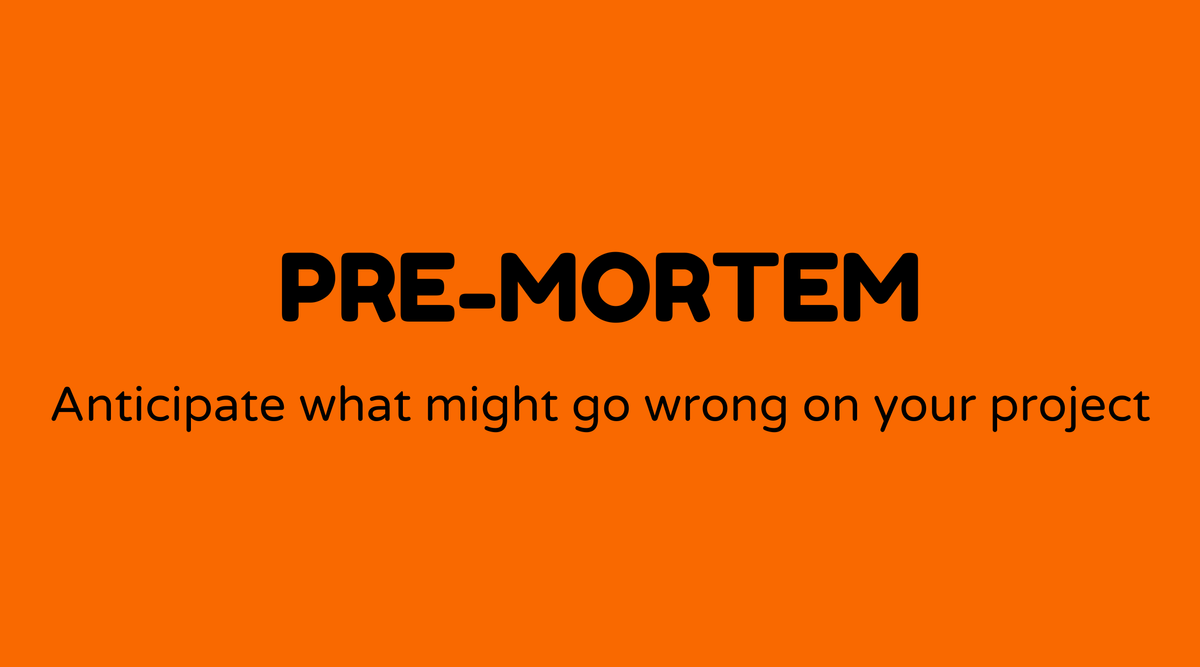Pre-mortem

Overview of Pre-mortem:
In the field of project management and product development, a pre-mortem functions as a valuable anticipatory session. Unlike a post-mortem, which investigates failures after a project's conclusion, a pre-mortem actively considers possible failures before they take place. This enables the team to address risks and refine strategies before fully committing to a project.
Why Pre-mortems Matters:
A pre-mortem is essential because it helps pinpoint potential obstacles that could hinder a project well in advance. With this foresight, teams can adapt, replan, and troubleshoot likely issues ahead of time. This forward-thinking approach conserves time and resources, often enhancing the likelihood of a project's success. Research published in the Harvard Business Review highlights how pre-mortems can enhance innovation efforts by fostering a culture of psychological safety and open communication among team members.
What is a Pre-mortem:
At its essence, a pre-mortem is a strategic planning exercise. The team convenes to visualize a future in which the project has failed. They then backtrack to ascertain how this failure might have transpired. The exercise consists of brainstorming all conceivable failure points and vulnerabilities, anticipating challenges, and devising solutions beforehand. It resembles war-gaming but is focused on projects.
How to Conduct a Pre-mortem:
Implementing a pre-mortem involves several steps:
-
Assemble the Team: Gather a diverse group of stakeholders, including project leaders, team members, and external advisors if necessary.
-
Define Success and Failure: Clearly articulate what constitutes success and failure.
-
Project into the Future: Encourage the team to envision a failed project and brainstorm possible causes. Encourage creative ideas to highlight less apparent risks.
-
Identify Key Risks: From the list of imagined failure causes, determine the most probable and impactful risks.
-
Create Action Plans: For each identified risk, develop actionable steps to either prevent it or mitigate its consequences.
-
Document and Review: Record the insights and revisit them regularly as the project advances. Adjust plans as necessary based on real-world events.
Sample Agenda of Pre-mortem
- Introduction (10 mins): Explain the purpose and process of the pre-mortem.
- Future Projection (20 mins): Enable team members to envision the end of the project and imagine its failure.
- Brainstorm Session (30 mins): Provide space for all possible reasons for failure to be discussed.
- Risk Identification (20 mins): Prioritize the most critical risks identified during brainstorming.
- Action Planning (30 mins): Formulate solutions and actions for recognized risks.
- Wrap-up and Next Steps (10 mins): Summarize key insights and outline steps for integration into the project plan.
Examples of Pre-mortem:
-
Software Development: A tech company conducts a pre-mortem to foresee possible software bugs and functionality issues before launching a new app.
-
Marketing Campaign: A marketing team anticipates unfavorable campaign reception due to audience targeting misalignments during their pre-mortem session.
-
Construction Project: A construction team identifies potential budget overruns by analyzing possible flaws and setbacks in their pre-mortem meeting.
FAQs
What are the benefits of conducting a pre-mortem?
Pre-mortems help identify and mitigate risks before they affect the project, promote open communication, and encourage structured risk management.
How often should a pre-mortem be conducted?
It’s advisable to conduct a pre-mortem before the initiation of any major project or when there are significant changes to the project scope or team.
Who should participate in a pre-mortem session?
Include a diverse group of stakeholders, including team members, project leaders, and possibly external advisors, to gain a comprehensive perspective on potential risks.
How is a pre-mortem different from a risk assessment?
While a risk assessment generally evaluates known risks based on past data and experiences, a pre-mortem imagines hypothetical future scenarios and potential points of failure.
Can pre-mortems be applied to personal projects?
Yes, pre-mortems can be beneficial for personal projects by assisting in future planning and anticipating possible obstacles.
What tools can aid in conducting a pre-mortem?
Tools like mind mapping software, collaborative platforms like Miro or Trello, and brainstorming tools can facilitate effective pre-mortem sessions.



